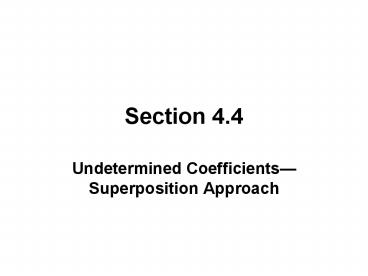Undetermined Coefficients Superposition Approach - PowerPoint PPT Presentation
1 / 10
Title:
Undetermined Coefficients Superposition Approach
Description:
is also a solution of the nonhomogeneous equation on the interval for any ... NOTE: s is the smallest nonnegative integer which will insure that no term of yp ... – PowerPoint PPT presentation
Number of Views:324
Avg rating:3.0/5.0
Title: Undetermined Coefficients Superposition Approach
1
Section 4.4
- Undetermined Coefficients Superposition Approach
2
SOLUTION OF NONHOMOGENEOUS EQUATIONS
Theorem Let y1, y2, . . . , yk be solutions of
the homogeneous linear nth-order differential
equation on an interval I, and let yp be any
solution of the nonhomogeneous equation on the
same interval. Then is also a solution of the
nonhomogeneous equation on the interval for any
constants c1, c2, . . . , ck.
3
EXISTENCE OF CONSTANTS
Theorem Let yp be a given solution of the
nonhomogeneous nth-order linear differential
equation on an interval I, and let y1, y2, . . .
, yn be a fundamental set of solutions of the
associated homogeneous equation on the interval.
Then for any solution Y(x) of the nonhomogeneous
equation on I, constants C1, C2, . . . , Cn can
be found so that
4
GENERAL SOLUTION NONHOMOGENEOUS EQUATION
Definition Let yp be a given solution of the
nonhomogeneous linear nth-order differential
equation on an interval I, and let denote the
general solution of the associated homogeneous
equation on the interval. The general solution
of the nonhomogeneous equation on the interval is
defined to be
5
COMPLEMENTARY FUNCTION
In the definition from the previous slide, the
linear combination is called the complementary
function for the nonhomogeneous equation. Note
that the general solution of a nonhomogeneous
equation is y complementary function any
particular solution.
6
SUPERPOSITION PRINCIPLE NONHOMOGENEOUS EQUATION
Theorem Let be k
particular solutions of the nonhomogeneous linear
nth-order differential equation on an open
interval I corresponding, in turn, to k distinct
functions g1, g2, . . . , gk. That is, suppose
denotes a particular solution of the
corresponding DE where i 1, 2, . . . , k.
Then is a particular solution of
7
FINDING A SOLUTION TO A NONHOMOGENEOUS LINEAR DE
To find the solution to a nonhomogeneous linear
differential equation with constant coefficients
requires two things (i) Find the complementary
function yc. (ii) Find any particular solution yp
of the nonhomoegeneous equation.
8
LIMITATIONS OF THE METHOD OF UNDETERMINED
COEFFICIENTS
The method of undetermined coefficients is
limited to nonhomogeneous equations
which coefficients are constant and g(x) is a
constant k, a polynomial function, an
exponential function eax, sin ßx, cos ßx, or
finite sums and products of these functions.
9
THE PARTICULAR SOLUTION OF ay? by' cy g(x)
NOTE s is the smallest nonnegative integer
which will insure that no term of yp(x) is a
solution of the corresponding homogeneous
equation.
10
HOMEWORK
141 odd































